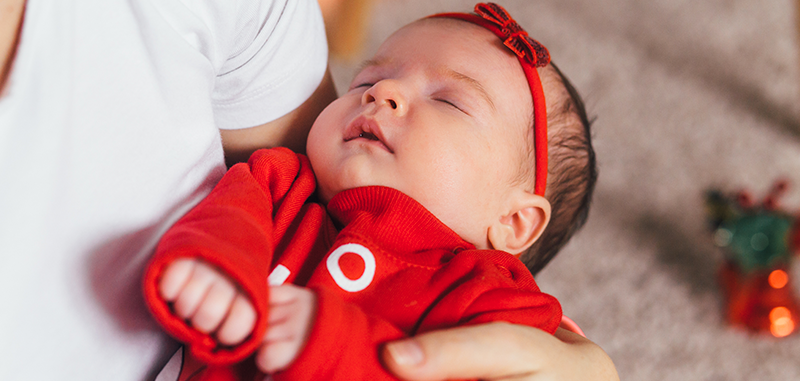Baby Sleep Cycles: A Parent’s Guide to Every Stage

Baby sleep can feel like a total mystery… but once you understand it, everything gets a little clearer (and nights a lot more restful!).
To truly understand how your child’s sleep evolves, you first need to grasp the concept of baby sleep cycles. In the early weeks, these cycles are very short—barely 50 minutes—and repeat around the clock, day and night, with a rhythm that can feel downright exhausting. Don’t worry—this stage doesn’t last forever!
Each baby sleep cycle is made up of different phases, which you can think of like “train cars” on a journey: there’s active sleep, quiet sleep, REM sleep, and later on, deeper sleep phases. These “cars” help your baby move from light to more restorative sleep.
The good news? Over time, these cycles get longer, more stable, and start to resemble an adult’s sleep pattern. That means your baby will gradually learn to sleep longer stretches at night, take more consistent naps, and (fingers crossed) wake up less often.
In this article, we’ll walk you through how baby sleep cycles change at every stage of development. You’ll see how naps and nighttime sleep evolve, and I’ll share practical tips to support these transitions—so you can hopefully enjoy more peaceful nights too!
Baby Sleep Cycles (0–2 Months): The “Ultradian” Rhythm
If you were hoping your newborn would sleep like an angel for hours on end… well, it might be time to adjust those expectations! During the first month, your baby’s sleep is beautifully chaotic. They sleep a lot—between 16 and 20 hours a day—but not in the long, uninterrupted stretches you may have dreamed of.
Why? Simply put: your baby doesn’t yet know the difference between day and night.
Their internal clock—the one that regulates our sleep based on light (known as the circadian rhythm)—isn’t developed yet. At birth, your baby follows what’s called an “ultradian” rhythm, meaning they cycle between sleep and wakefulness throughout the day and night without distinction.
Here’s what you can expect:
- Total sleep per day: Around 16 to 20 hours, split between 8 to 10 hours at night (with multiple feedings) and 8 to 10 hours of daytime naps.
- Length of sleep periods: Whether it’s day or night, babies usually sleep in stretches of 2 to 4 hours at a time.
- Awake time: Your baby can only stay awake for 30 to 60 minutes before needing to sleep again. That means it's important to watch for tired cues and put them down at the right moment.
- Baby sleep cycles: Each nap or sleep session is made up of cycles lasting around 50 to 60 minutes. These include two main phases:
Active sleep: baby may squirm, make faces, flail their arms—it doesn’t look much like peaceful slumber.
Quiet sleep: baby lies still and relaxed—this is when real rest happens.
Rest assured—it’s completely normal for your little one to sleep in short bursts and wake often to feed.
Their needs change rapidly, but for now, it’s all about sleep and feeding. Yes, your nights will still be interrupted, but hang in there—it really won’t last forever (we promise!).

Baby Sleep Cycles from 3 to 7 Months: The Start of the “Circadian” Rhythm
Between 3 and 4 months, your baby’s sleep enters a new stage, showing the first signs of developing a circadian rhythm. That means your little one is slowly but surely starting to distinguish day from night. Good news for you! But before you celebrate too much, keep in mind that baby sleep cycles are still fairly short, and night wakings may not be behind you just yet. Here’s what you need to know about baby sleep at this stage:
- Total sleep time: Most babies sleep between 14 and 18 hours per day, with an average around 16 hours. Night sleep: Your baby might sleep 9 to 12 hours at night, but still wake up 1 to 3 times for feeding.
- Daytime naps: Around 5 to 6 hours of sleep, spread across 3 to 6 naps ranging from 30 minutes to 4 hours.
- Wake windows: After being awake for 1 to 1.5 hours, it’s time to offer a nap—waiting too long can lead to overtiredness and make falling asleep harder.
Along with sleeping for longer stretches, baby’s sleep cycles are also getting longer. From 50 minutes at birth, they now last around 60 minutes—or a little more. It may still seem short, but every extra minute helps build more stable sleep. Cycle composition: The “sleep train” At this stage, your baby’s sleep cycles include several “cars” that follow this sequence:
- REM sleep (formerly called active sleep): the dream phase, when baby moves a lot.
- Light non-REM sleep: baby is calmer, but still easily woken.
- Deep non-REM sleep: the most restorative phase, when baby is completely relaxed.
These more structured cycles help pave the way for longer nighttime sleep. However, don’t be surprised if your baby still wakes up—especially to feed. These wakings are totally normal and part of learning to sleep independently.
Tip: Be patient and adapt to your baby’s rhythm. They’re in a big transition phase, and with time, their sleep will naturally become more regulated. And what about those nighttime wakings? At this stage, it’s still common for babies to wake once to three times during the night to feed. Many start to space out feedings naturally from 4 months on. But don’t stress—every baby progresses at their own pace.
Around 6 months of age and once your baby weighs over 6 kg, some are able to sleep through the night without needing to eat. That said, if your baby isn’t quite there yet, don’t worry. Night feeding depends on several factors: age, weight, stomach size, and for breastfed babies, how much milk the mother can store. Sometimes babies stop needing night feeds… and then suddenly need them again! The key is to follow your baby’s rhythm—because every baby is unique!
The tricky part is that once awake, they’re not always able to hop back on the next sleep train on their own! The idea is simple: the longer the sleep cycles, the more likely baby is to stay asleep. Fewer stops means fewer wake-ups! That’s why, as sleep cycles gradually lengthen, you’ll notice their nights start to improve—with fewer and fewer interruptions. But don’t worry—every baby moves at their own pace. Those precious full nights will come once sleep cycles become longer and more stable. Hang in there!
Different experiences for different babies: Some families find their baby sleeps 6 hours straight as early as 4 months, while others may wait until 6—or even 9—months before enjoying peaceful nights. Curious to learn more? Check out our full article on the topic: When Will My Baby Sleep Through the Night? What Science Says

7 to 23 Months: Toward More Stability—But Night Wakings May Still Happen
Between 7 and 23 months, your baby continues progressing toward more stable sleep—but night wakings can still occur. The good news? You’re on the right track, even if nights aren’t always completely uninterrupted.
Here’s what to know about your baby’s sleep at this stage:
- Total sleep duration: Baby needs about 13 to 17 hours of sleep per day, with an average of 14 to 15 hours.
- Nighttime sleep: At night, your child may sleep between 10 and 13 hours straight. However, 10 hours is considered on the shorter side—most toddlers at this age need 11 to 12 hours for proper rest.
- Daytime naps: Between 7 and 10 months, most babies transition to two naps per day—one in the morning and one in the early afternoon. These naps typically last 1 to 2.5 or even 3 hours each, for a total of 2.5 to 4 hours of daytime sleep.
- Wake windows: To avoid overstimulation and trouble falling asleep, it’s important to respect ideal wake times: no more than 2 hours in the morning, 2 to 3 hours around midday, and up to 4 hours before bedtime if the last nap was short.
At this point, your little one is entering a stage where sleep becomes more structured and stable. Still, every baby is different, and their sleep needs can vary from day to day.
Cycle composition: The “sleep train” At this age, babies typically begin falling asleep directly into light non-REM sleep, followed by deep sleep. This shift is important—it means your baby is spending more time in restorative sleep, which improves overall sleep quality. Sleep cycles continue to lengthen, now reaching around 70 minutes. We’re getting closer to adult-like sleep cycles, which last 90 to 120 minutes. Longer cycles help your baby link them together more easily without waking up.
Around 12 months, as your baby learns to stand and eventually walk, naps may become more challenging. Your little one is increasingly stimulated by their environment—and their growing desire to move.
Contrary to what you might think, babies don’t “make up” for missed naps by sleeping longer at night. In fact, skipping naps—or mistiming them—can make bedtime much more difficult and throw off your baby’s overall balance. Naps help your child recharge, process everything they’re learning, and improve the quality of their nighttime sleep.

Sleep at Age 2 and Beyond: A Consistent Routine Is Key!
From age 2 onward, your child’s sleep reaches a new level of stability: sleep cycles are now fully developed and last about 90 minutes—just like an adult’s.
At this stage, your child typically sleeps 13 to 16 hours over a 24-hour period, including a solid night of 10 to 13 hours without interruptions. Although naps are reduced to just one per day, they remain essential to help your child recover and recharge. Wake windows also get longer, with stretches of 4 to 5 hours between rest periods. At this age, the key to peaceful nights is having a solid, predictable bedtime routine.
A calm and supportive sleep environment encourages not only better rest, but also helps your child learn to fall back asleep independently during brief night wakings. And let’s not forget—by around age 3, with the emergence of deep slow-wave sleep, your child’s sleep becomes almost identical to that of an adult.
Overview of Baby Sleep Cycle Development from Birth to Age 5
- 0 to 2 months: At this age, baby sleep cycles are very short (around 50 minutes) and include mainly two phases: active sleep (where baby moves, makes faces, and breathes irregularly) and quiet sleep (where they are still and relaxed).
- 2 to 6/9 months: Sleep cycles begin to lengthen (around 60 minutes). Sleep becomes more varied, with the appearance of REM sleep—the dreaming phase with intense brain activity, evolved from early active sleep.
- 6/9 months to 3 years: Baby sleep cycles grow longer, lasting between 70 and 90 minutes. Baby’s sleep also changes: they no longer fall asleep in active/REM sleep, but instead start with light non-REM sleep—just like adults.
- Around 3 to 4 years: Sleep cycles reach 90–120 minutes (the same as adults), and sleep becomes more consolidated with the appearance of “very deep slow-wave sleep.”
| 🧒 Age | ⏰ Nighttime Sleep Duration | ⏱️ Wake Time | 😴 Naps | 🛏️ Duration & Distribution |
|---|---|---|---|---|
| 0 to 1 month | 8 to 10 hours | 30 min to 1 hour | Frequent naps | Fragmented sleep with multiple night wakings for feeding (ultradian rhythm) |
| 2 to 3 months | 9 to 12 hours | 1 to 1.5 hours | 3 to 6 naps | Begins to recognize day/night cycle (circadian rhythm) |
| 4 to 7 months | 10 to 13 hours | 1.5 to 2 hours | 3 to 4 naps | More alert during wake windows; night wakings still common |
| 8 to 14 months | 10 to 13 hours | 1h45 to 2.5 hours | 2 naps | Longer wake windows, fewer night wakings |
| 15 to 23 months | 10 to 13 hours | 2 to 4 hours | 1 to 2 naps | Longer periods of wakefulness, more consolidated night sleep |
| 2 to 3 years | 11 to 13 hours | 4 to 5 hours | 1 nap | More consistent nighttime sleep, shorter daytime naps |
Discover REMI
THE SMART ALARM CLOCK 😊
REMI and its app bring together everything you need to manage your baby’s sleep!
Its mission? Helping families sleep better — from birth up to age 10.
I bought REMI for my 4-year-old son who didn’t want to sleep alone anymore after his little sister was born. Thanks to the remote wake-up system and bedtime stories I can play from a distance, the issue is completely resolved! I 100% recommend this purchase!






 My Child Won’t Sleep Alone: How to Help Them Gain Independence
My Child Won’t Sleep Alone: How to Help Them Gain Independence
 Letting Baby Cry It Out: Effective, But At What Cost?
Letting Baby Cry It Out: Effective, But At What Cost?
 White noise for baby : a scientific research !
White noise for baby : a scientific research !
 What are the positive effects of napping on memory?
What are the positive effects of napping on memory?
 What Time Should Your Child Go to Bed? The Ideal Bedtime by Age!
What Time Should Your Child Go to Bed? The Ideal Bedtime by Age!